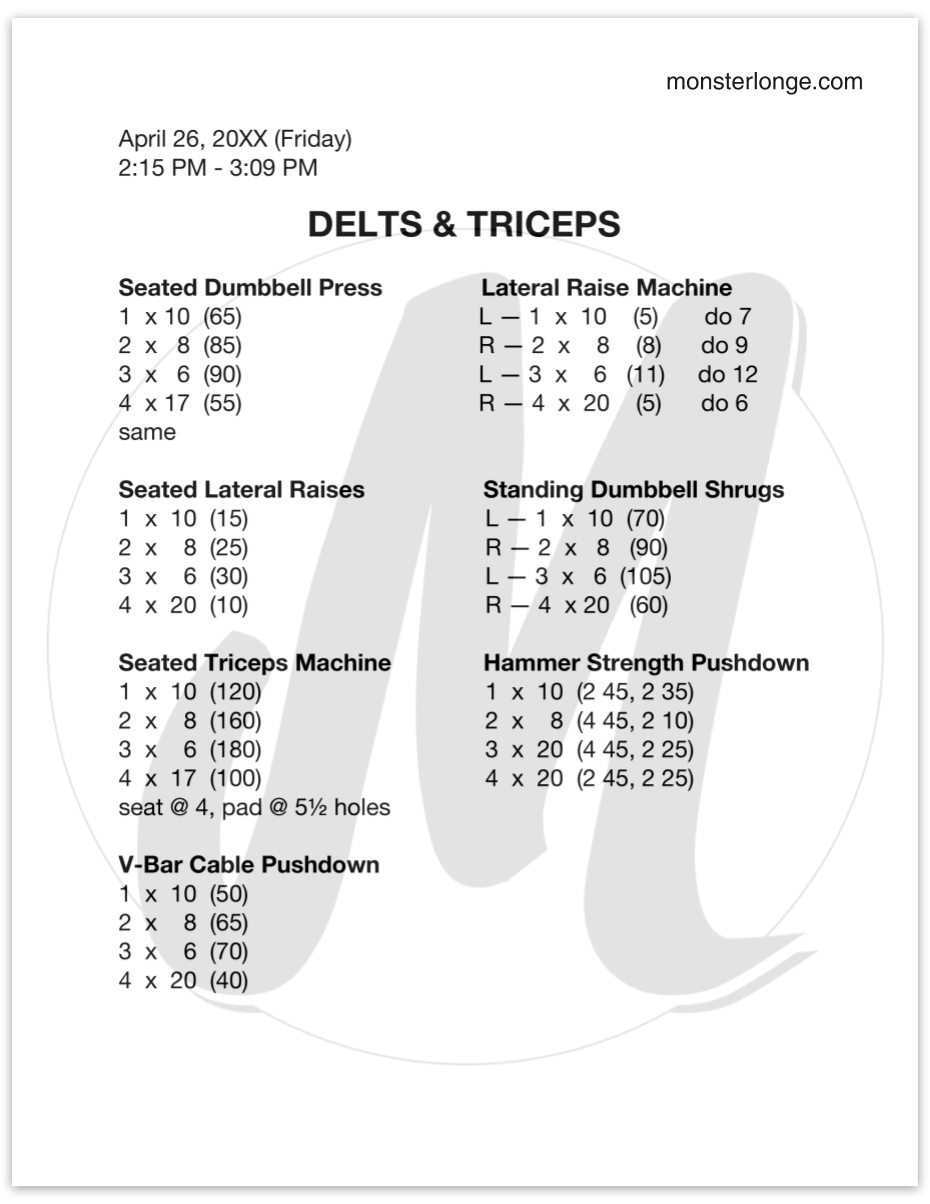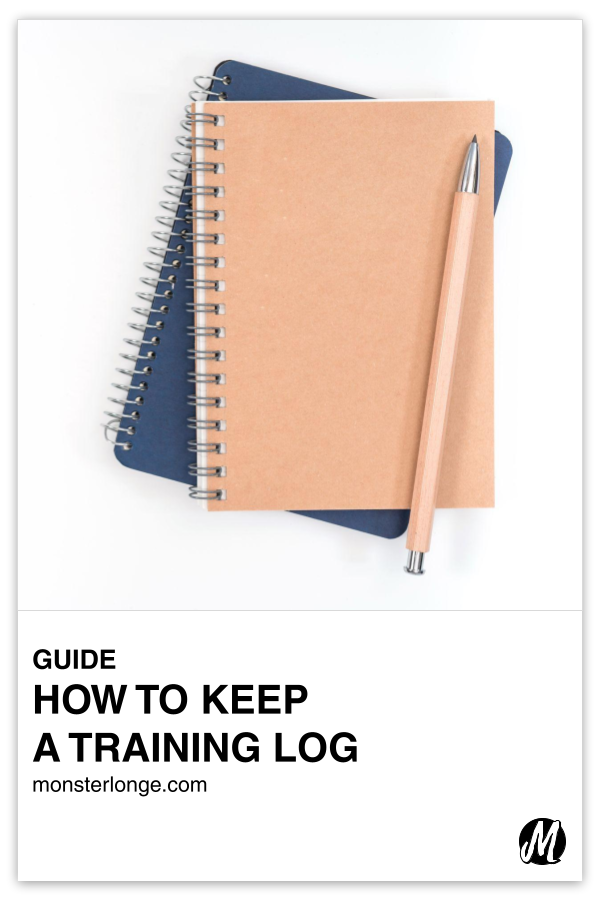How To Track Workouts With A Training Log
I’m going to show you how to track your workouts, something that’s very important to do if you want results.
Know why?
Yup, because the name of the game is progressive overload, or changing the amount of stress placed on the body in order to force a physical adaptation in the form of strength and muscle size.
How you achieve overload is by progressively altering the stimuli over training sessions. This can occur by attempting to increase the amount of weight, number of reps, or quantity of sets that you do; raising and lowering the weight at a different tempo; placing the muscle under greater time under tension; or performing the exact same workout routine in less time than you did the workout prior.
That’s why keeping a record of your lifts in a training log is important. Recordkeeping helps you plan your workouts so you know exactly what adjustments to make, which can prevent you from hitting a plateau. Also, because a log allows you to look back at any period in time, it can help you break out of a rut and determine whether or not you’re making progress. It further helps to be able to flip back to remind yourself of the load and various details when you reintroduce an exercise to your routine after replacing it.
True, it’s possible to do all of that without a log. However, with everything in your life you want or need to remember, it’s not necessarily ideal to depend on memory alone. The odds are high that you’ll forget what you did in the gym when you try to recall it days, weeks, months later.1Some of the things vying for space in your memory bank include: the lie you told your boss to get the day off last time so you don’t repeat it the next time you need an excuse, random bits of trivia about things no one gives a fuck about, and remembering to nuke your laptop’s hard drive so your family doesn’t stumble onto the freak shit you’re into if you don’t wake up from anesthesia and instead fall into a coma during that routine dental procedure you’re undergoing in a few days.
With you now understanding the importance of keeping a journal, we should probably get to the how part, huh?
Fuck, you’re so impatient!
This is the technological age so your workout journal can take the form of a smartphone app, personal blog, website forum, or Excel spreadsheet. But for the sake of making this more educational, I’m going to assume that you’re a dinosaur. And with you being the dinosaur I assume you to be, I’m going to show you how to track your workout in a good old-fashioned notebook.2In full transparency, fuck your education. I’m showing you how to keep track of your stats in a notebook to boost up the word count for SEO purposes.
Oh, and by “notebook”, I mean a small book composed of blank pieces of paper for you to write on. Yeah, one of those archaic things — NOT a laptop computer! The following are the steps you should take to fill out that notebook.3You still remember how to grip a pen or pencil and move your hand to form written letters, right? Sorry, everyone types nowadays so I have to do my due diligence in making sure!
1) Before the workout begins, like the night before, write down the date and day of the week the workout is taking place on.
2) Write down the muscle group(s) you’re training.
3) Write down the name of an exercise movement, the amount of sets you’re doing that exercise for, and the weights you’re going to perform each set with. Leave a blank space for the number of repetitions.
4) This step is totally optional, but before moving on to repeat step #3 for the remaining exercises that you plan on performing during that workout, it’s in your best interest to leave a little space for a notes section.
5) Begin your workout and write down the starting time.
6) As you work out, record the reps you’re doing set-by-set. Additionally, scribble down any changes made, such as if you added or decreased the weight you’re using from what you had originally written down.
7) In the notes section, write how many pounds and/or reps you should do next time; if you experienced any pain during the movement; felt you quit too early and could have did more reps or used more weight; if your technique was off; the seat or handle setting for that piece of equipment; a cue you discovered that helped you better feel the exercise; and various other miscellany.
8) Repeat steps 6-7 until your workout is over.
9) Write down the time your workout ends.

The sample entry you just gave the once-over to is an actual entry from one of my many, many training journals.4Yes, I actually do some of the shit I tell you people to do. Imagine that! Although this particular workout took place a few years ago, many things about it and how I was training then are coming back to me. But before I take you on a meandering stroll down memory lane, let’s get back to you. The sample journal entry above is what yours should look like after a workout. It reads like this:
Delts and triceps were trained on the Friday afternoon of April 26, 20XX. Seated dumbbell press was the first exercise. For the first, second, and third set, I was able to hit my rep targets of 10, 8, and 6 with 65, 85, and 90 lbs dumbbells, respectively. On the fourth set, however, I didn’t complete 20 reps when I grabbed a pair of 55s. Because I didn’t meet my mark, and probably combined with how the weight felt for the lifts that day, I wrote “same” to remind myself to use the same weight for all the sets the next training session.
On the first set of machine lateral raises, I performed the movement with my left arm for straight sets before switching to the opposite arm and doing the same. Because I hit all my rep targets for every set with the weights I prescribed, and probably combined with how the weight felt, I told myself that I have to add more weight. So the next time I do this movement and get to the last set, for example, I should place the pin in the 6th hole. And because I alternate the hand that I perform the exercise with, I know to begin that set with my left when I refer to this workout to write the next one.
On seated lateral raises, there’s nothing written telling me that I have to stay at the same weight or that I have to add more. That means I’m free to bump the weight up or stay where I’m at for another session to see if I can have a repeat or better performance. If I don’t decide the day before as I’m reviewing this workout in preparation for the one that’s coming up, then I’ll decide on the fly based on my strength and energy levels during the workout.
On the seated triceps machine, I noted that the seat was set to 4 and that 5.5 holes were showing when the back support was secured. With me writing that down, I don’t have to waste time trying to line everything up to fit my body specifications. Instead, I can just look at my journal, make the proper adjustments to the machine, and get right into my set.
Notice how the weight is listed on the Hammer Strength pushdown machine, which is different from how weight is listed elsewhere to denote a pair of dumbbells or slot in a pin-loaded piece of equipment. When I use a plate-loaded machine, I write down the number of varying plates used. The reason for writing it that way rather than listing the total weight is so I don’t have to do the math of figuring out what assortment of plates I need to rack the machine with. So when we look at the third set of Hammer Strength pushdowns, which calls for 4 45 and 2 25, it’s a lot easier to know that two 45 lbs plates and one 25 lbs plate have to be placed on each side of the machine as opposed to scratching my head at what plates are needed to equal 230 lbs.5I’m a bodybuilder, NOT a mathematician!!!
Lastly, the workout began at 2:15 and ended at 3:09. It took me 54 minutes to complete it. If it takes me less time in the next and future sessions, then I’m working out with greater intensity and becoming more efficient. If the routine takes longer, then it’s a sign that my intensity is lacking and I need to pick it up.
Do you have to track your workouts?
No, but it has a lot of benefits and it’s not the most time-consuming or hardest thing to do.
So you probably should track your workouts.
But will you?
Hmmmm…now that’s the question!
Glossary: bodybuilder, dumbbell, exercise, gym, intensity, muscle, muscle group, results, routine, work out, workout

